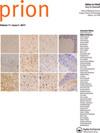Combining autophagy stimulators and cellulose ethers for therapy against prion disease
IF 1.6
3区 生物学
Q4 BIOCHEMISTRY & MOLECULAR BIOLOGY
引用次数: 19
Abstract
ABSTRACT Prion diseases are fatal transmissible neurodegenerative disorders that affect animals and humans. Prions are proteinaceous infectious particles consisting of a misfolded isoform of the cellular prion protein PrPC, termed PrPSc. PrPSc accumulates in infected neurons due to partial resistance to proteolytic digestion. Using compounds that interfere with the production of PrPSc or enhance its degradation cure prion infection in vitro, but most drugs failed when used to treat prion-infected rodents. In order to synergize the effect of anti-prion drugs, we combined drugs interfering with the generation of PrPSc with compounds inducing PrPSc degradation. Here, we tested autophagy stimulators (rapamycin or AR12) and cellulose ether compounds (TC-5RW or 60SH-50) either as single or combination treatment of mice infected with RML prions. Single drug treatments significantly extended the survival compared to the untreated group. As anticipated, also all the combination therapy groups showed extended survival compared to the untreated group, but no combination treatment showed superior effects to 60SH-50 or TC-5RW treatment alone. Unexpectedly, we later found that combining autophagy stimulator and cellulose ether treatment in cultured neuronal cells mitigated the pro-autophagic activity of AR12 and rapamycin, which can in part explain the in vivo results. Overall, we show that it is critical to exclude antagonizing drug effects when attempting combination therapy. In addition, we identified AR-12 as a pro-autophagic drug that significantly extends survival of prion-infected mice, has no adverse side effects on the animals used in this study, and can be useful in future studies.结合自噬刺激剂和纤维素醚治疗朊病毒病
朊病毒疾病是一种致命的可传播的神经退行性疾病,影响动物和人类。朊病毒是由细胞朊病毒蛋白PrPC的错误折叠异构体组成的蛋白质感染性颗粒,称为PrPSc。PrPSc由于对蛋白水解消化的部分抵抗而在受感染的神经元中积累。使用干扰PrPSc产生或增强其降解的化合物可以在体外治愈朊病毒感染,但大多数药物在治疗朊病毒感染的啮齿动物时都失败了。为了协同抗朊病毒药物的作用,我们将干扰PrPSc产生的药物与诱导PrPSc降解的化合物相结合。在这里,我们测试了自噬刺激剂(雷帕霉素或AR12)和纤维素醚化合物(TC-5RW或60SH-50)作为单一或组合治疗感染RML朊病毒的小鼠。与未治疗组相比,单药治疗显著延长了生存期。正如预期的那样,与未治疗组相比,所有联合治疗组都显示出延长的生存期,但没有任何联合治疗显示出优于60SH-50或TC-5RW单独治疗的效果。出乎意料的是,我们后来发现,在培养的神经元细胞中结合自噬刺激剂和纤维素醚处理可以减轻AR12和雷帕霉素的促自噬活性,这可以部分解释体内结果。总的来说,我们表明,在尝试联合治疗时,排除拮抗药物作用是至关重要的。此外,我们确定AR-12是一种促自噬药物,可显著延长朊病毒感染小鼠的存活时间,对本研究中使用的动物没有不良副作用,并可用于未来的研究。
本文章由计算机程序翻译,如有差异,请以英文原文为准。
求助全文
约1分钟内获得全文
求助全文
来源期刊

Prion
生物-生化与分子生物学
CiteScore
5.20
自引率
4.30%
发文量
13
审稿时长
6-12 weeks
期刊介绍:
Prion is the first international peer-reviewed open access journal to focus exclusively on protein folding and misfolding, protein assembly disorders, protein-based and structural inheritance. The goal is to foster communication and rapid exchange of information through timely publication of important results using traditional as well as electronic formats. The overriding criteria for publication in Prion are originality, scientific merit and general interest.
 求助内容:
求助内容: 应助结果提醒方式:
应助结果提醒方式:


